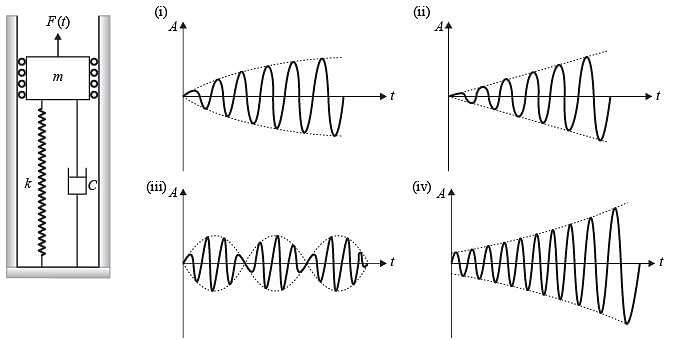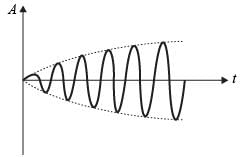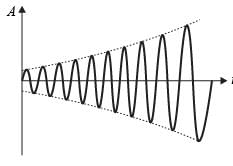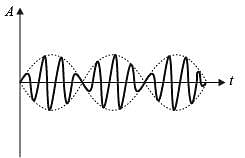Mechanical Engineering Exam > Mechanical Engineering Questions > A spring mass damper system (mass m, stiffnes...
Start Learning for Free
A spring mass damper system (mass m, stiffness k, and damping coefficient c) excited by a force (��) = B sin ����, where B, �� and �� are the amplitude, frequency and time, respectively, is shown in the figure. Four different responses of the system (marked as (i) to (iv)) are shown just to the right of the system figure. In the figures of the responses, A is the amplitude of response shown in red color and the dashed lines indicate its envelope. The responses represent only the qualitative trend and those are not drawn to any specific scale.

Four different parameter and forcing conditions are mentioned below.

Which one of the following options gives correct match (indicated by arrow →) of the parameter and forcing conditions to the responses?

Four different parameter and forcing conditions are mentioned below.

Which one of the following options gives correct match (indicated by arrow →) of the parameter and forcing conditions to the responses?
- a)(P) → (i), (Q) → (iii), (R) → (iv), (S) → (ii)
- b)(P) → (ii), (Q) → (iii), (R) → (iv), (S) → (i)
- c)(P) → (i), (Q) → (iv), (R) → (ii), (S) → (iii)
- d)(P) → (iii), (Q) → (iv), (R) → (ii), (S) → (i)
Correct answer is option 'C'. Can you explain this answer?
| FREE This question is part of | Download PDF Attempt this Test |
Most Upvoted Answer
A spring mass damper system (mass m, stiffness k, and damping coeffici...


(Q) c < 0 and ω ≠ 0




Hence, the correct option is (C).
Attention Mechanical Engineering Students!
To make sure you are not studying endlessly, EduRev has designed Mechanical Engineering study material, with Structured Courses, Videos, & Test Series. Plus get personalized analysis, doubt solving and improvement plans to achieve a great score in Mechanical Engineering.

|
Explore Courses for Mechanical Engineering exam
|

|
Similar Mechanical Engineering Doubts
A spring mass damper system (mass m, stiffness k, and damping coefficient c) excited by a force (��) = B sin ����, where B, �� and �� are the amplitude, frequency and time, respectively, is shown in the figure. Four different responses of the system (marked as (i) to (iv)) are shown just to the right of the system figure. In the figures of the responses, A is the amplitude of response shown in red color and the dashed lines indicateits envelope. The responses represent only the qualitative trend and those are not drawn to any specific scale.Four different parameter and forcing conditions are mentioned below.Which one of the following options gives correct match (indicated by arrow →) of the parameter and forcing conditions to the responses?a)(P) → (i), (Q) → (iii), (R) → (iv), (S) → (ii)b)(P) → (ii), (Q) → (iii), (R) → (iv), (S) → (i)c)(P) → (i), (Q) → (iv), (R) → (ii), (S) → (iii)d)(P) → (iii), (Q) → (iv), (R) → (ii), (S) → (i)Correct answer is option 'C'. Can you explain this answer?
Question Description
A spring mass damper system (mass m, stiffness k, and damping coefficient c) excited by a force (��) = B sin ����, where B, �� and �� are the amplitude, frequency and time, respectively, is shown in the figure. Four different responses of the system (marked as (i) to (iv)) are shown just to the right of the system figure. In the figures of the responses, A is the amplitude of response shown in red color and the dashed lines indicateits envelope. The responses represent only the qualitative trend and those are not drawn to any specific scale.Four different parameter and forcing conditions are mentioned below.Which one of the following options gives correct match (indicated by arrow →) of the parameter and forcing conditions to the responses?a)(P) → (i), (Q) → (iii), (R) → (iv), (S) → (ii)b)(P) → (ii), (Q) → (iii), (R) → (iv), (S) → (i)c)(P) → (i), (Q) → (iv), (R) → (ii), (S) → (iii)d)(P) → (iii), (Q) → (iv), (R) → (ii), (S) → (i)Correct answer is option 'C'. Can you explain this answer? for Mechanical Engineering 2024 is part of Mechanical Engineering preparation. The Question and answers have been prepared according to the Mechanical Engineering exam syllabus. Information about A spring mass damper system (mass m, stiffness k, and damping coefficient c) excited by a force (��) = B sin ����, where B, �� and �� are the amplitude, frequency and time, respectively, is shown in the figure. Four different responses of the system (marked as (i) to (iv)) are shown just to the right of the system figure. In the figures of the responses, A is the amplitude of response shown in red color and the dashed lines indicateits envelope. The responses represent only the qualitative trend and those are not drawn to any specific scale.Four different parameter and forcing conditions are mentioned below.Which one of the following options gives correct match (indicated by arrow →) of the parameter and forcing conditions to the responses?a)(P) → (i), (Q) → (iii), (R) → (iv), (S) → (ii)b)(P) → (ii), (Q) → (iii), (R) → (iv), (S) → (i)c)(P) → (i), (Q) → (iv), (R) → (ii), (S) → (iii)d)(P) → (iii), (Q) → (iv), (R) → (ii), (S) → (i)Correct answer is option 'C'. Can you explain this answer? covers all topics & solutions for Mechanical Engineering 2024 Exam. Find important definitions, questions, meanings, examples, exercises and tests below for A spring mass damper system (mass m, stiffness k, and damping coefficient c) excited by a force (��) = B sin ����, where B, �� and �� are the amplitude, frequency and time, respectively, is shown in the figure. Four different responses of the system (marked as (i) to (iv)) are shown just to the right of the system figure. In the figures of the responses, A is the amplitude of response shown in red color and the dashed lines indicateits envelope. The responses represent only the qualitative trend and those are not drawn to any specific scale.Four different parameter and forcing conditions are mentioned below.Which one of the following options gives correct match (indicated by arrow →) of the parameter and forcing conditions to the responses?a)(P) → (i), (Q) → (iii), (R) → (iv), (S) → (ii)b)(P) → (ii), (Q) → (iii), (R) → (iv), (S) → (i)c)(P) → (i), (Q) → (iv), (R) → (ii), (S) → (iii)d)(P) → (iii), (Q) → (iv), (R) → (ii), (S) → (i)Correct answer is option 'C'. Can you explain this answer?.
A spring mass damper system (mass m, stiffness k, and damping coefficient c) excited by a force (��) = B sin ����, where B, �� and �� are the amplitude, frequency and time, respectively, is shown in the figure. Four different responses of the system (marked as (i) to (iv)) are shown just to the right of the system figure. In the figures of the responses, A is the amplitude of response shown in red color and the dashed lines indicateits envelope. The responses represent only the qualitative trend and those are not drawn to any specific scale.Four different parameter and forcing conditions are mentioned below.Which one of the following options gives correct match (indicated by arrow →) of the parameter and forcing conditions to the responses?a)(P) → (i), (Q) → (iii), (R) → (iv), (S) → (ii)b)(P) → (ii), (Q) → (iii), (R) → (iv), (S) → (i)c)(P) → (i), (Q) → (iv), (R) → (ii), (S) → (iii)d)(P) → (iii), (Q) → (iv), (R) → (ii), (S) → (i)Correct answer is option 'C'. Can you explain this answer? for Mechanical Engineering 2024 is part of Mechanical Engineering preparation. The Question and answers have been prepared according to the Mechanical Engineering exam syllabus. Information about A spring mass damper system (mass m, stiffness k, and damping coefficient c) excited by a force (��) = B sin ����, where B, �� and �� are the amplitude, frequency and time, respectively, is shown in the figure. Four different responses of the system (marked as (i) to (iv)) are shown just to the right of the system figure. In the figures of the responses, A is the amplitude of response shown in red color and the dashed lines indicateits envelope. The responses represent only the qualitative trend and those are not drawn to any specific scale.Four different parameter and forcing conditions are mentioned below.Which one of the following options gives correct match (indicated by arrow →) of the parameter and forcing conditions to the responses?a)(P) → (i), (Q) → (iii), (R) → (iv), (S) → (ii)b)(P) → (ii), (Q) → (iii), (R) → (iv), (S) → (i)c)(P) → (i), (Q) → (iv), (R) → (ii), (S) → (iii)d)(P) → (iii), (Q) → (iv), (R) → (ii), (S) → (i)Correct answer is option 'C'. Can you explain this answer? covers all topics & solutions for Mechanical Engineering 2024 Exam. Find important definitions, questions, meanings, examples, exercises and tests below for A spring mass damper system (mass m, stiffness k, and damping coefficient c) excited by a force (��) = B sin ����, where B, �� and �� are the amplitude, frequency and time, respectively, is shown in the figure. Four different responses of the system (marked as (i) to (iv)) are shown just to the right of the system figure. In the figures of the responses, A is the amplitude of response shown in red color and the dashed lines indicateits envelope. The responses represent only the qualitative trend and those are not drawn to any specific scale.Four different parameter and forcing conditions are mentioned below.Which one of the following options gives correct match (indicated by arrow →) of the parameter and forcing conditions to the responses?a)(P) → (i), (Q) → (iii), (R) → (iv), (S) → (ii)b)(P) → (ii), (Q) → (iii), (R) → (iv), (S) → (i)c)(P) → (i), (Q) → (iv), (R) → (ii), (S) → (iii)d)(P) → (iii), (Q) → (iv), (R) → (ii), (S) → (i)Correct answer is option 'C'. Can you explain this answer?.
Solutions for A spring mass damper system (mass m, stiffness k, and damping coefficient c) excited by a force (��) = B sin ����, where B, �� and �� are the amplitude, frequency and time, respectively, is shown in the figure. Four different responses of the system (marked as (i) to (iv)) are shown just to the right of the system figure. In the figures of the responses, A is the amplitude of response shown in red color and the dashed lines indicateits envelope. The responses represent only the qualitative trend and those are not drawn to any specific scale.Four different parameter and forcing conditions are mentioned below.Which one of the following options gives correct match (indicated by arrow →) of the parameter and forcing conditions to the responses?a)(P) → (i), (Q) → (iii), (R) → (iv), (S) → (ii)b)(P) → (ii), (Q) → (iii), (R) → (iv), (S) → (i)c)(P) → (i), (Q) → (iv), (R) → (ii), (S) → (iii)d)(P) → (iii), (Q) → (iv), (R) → (ii), (S) → (i)Correct answer is option 'C'. Can you explain this answer? in English & in Hindi are available as part of our courses for Mechanical Engineering.
Download more important topics, notes, lectures and mock test series for Mechanical Engineering Exam by signing up for free.
Here you can find the meaning of A spring mass damper system (mass m, stiffness k, and damping coefficient c) excited by a force (��) = B sin ����, where B, �� and �� are the amplitude, frequency and time, respectively, is shown in the figure. Four different responses of the system (marked as (i) to (iv)) are shown just to the right of the system figure. In the figures of the responses, A is the amplitude of response shown in red color and the dashed lines indicateits envelope. The responses represent only the qualitative trend and those are not drawn to any specific scale.Four different parameter and forcing conditions are mentioned below.Which one of the following options gives correct match (indicated by arrow →) of the parameter and forcing conditions to the responses?a)(P) → (i), (Q) → (iii), (R) → (iv), (S) → (ii)b)(P) → (ii), (Q) → (iii), (R) → (iv), (S) → (i)c)(P) → (i), (Q) → (iv), (R) → (ii), (S) → (iii)d)(P) → (iii), (Q) → (iv), (R) → (ii), (S) → (i)Correct answer is option 'C'. Can you explain this answer? defined & explained in the simplest way possible. Besides giving the explanation of
A spring mass damper system (mass m, stiffness k, and damping coefficient c) excited by a force (��) = B sin ����, where B, �� and �� are the amplitude, frequency and time, respectively, is shown in the figure. Four different responses of the system (marked as (i) to (iv)) are shown just to the right of the system figure. In the figures of the responses, A is the amplitude of response shown in red color and the dashed lines indicateits envelope. The responses represent only the qualitative trend and those are not drawn to any specific scale.Four different parameter and forcing conditions are mentioned below.Which one of the following options gives correct match (indicated by arrow →) of the parameter and forcing conditions to the responses?a)(P) → (i), (Q) → (iii), (R) → (iv), (S) → (ii)b)(P) → (ii), (Q) → (iii), (R) → (iv), (S) → (i)c)(P) → (i), (Q) → (iv), (R) → (ii), (S) → (iii)d)(P) → (iii), (Q) → (iv), (R) → (ii), (S) → (i)Correct answer is option 'C'. Can you explain this answer?, a detailed solution for A spring mass damper system (mass m, stiffness k, and damping coefficient c) excited by a force (��) = B sin ����, where B, �� and �� are the amplitude, frequency and time, respectively, is shown in the figure. Four different responses of the system (marked as (i) to (iv)) are shown just to the right of the system figure. In the figures of the responses, A is the amplitude of response shown in red color and the dashed lines indicateits envelope. The responses represent only the qualitative trend and those are not drawn to any specific scale.Four different parameter and forcing conditions are mentioned below.Which one of the following options gives correct match (indicated by arrow →) of the parameter and forcing conditions to the responses?a)(P) → (i), (Q) → (iii), (R) → (iv), (S) → (ii)b)(P) → (ii), (Q) → (iii), (R) → (iv), (S) → (i)c)(P) → (i), (Q) → (iv), (R) → (ii), (S) → (iii)d)(P) → (iii), (Q) → (iv), (R) → (ii), (S) → (i)Correct answer is option 'C'. Can you explain this answer? has been provided alongside types of A spring mass damper system (mass m, stiffness k, and damping coefficient c) excited by a force (��) = B sin ����, where B, �� and �� are the amplitude, frequency and time, respectively, is shown in the figure. Four different responses of the system (marked as (i) to (iv)) are shown just to the right of the system figure. In the figures of the responses, A is the amplitude of response shown in red color and the dashed lines indicateits envelope. The responses represent only the qualitative trend and those are not drawn to any specific scale.Four different parameter and forcing conditions are mentioned below.Which one of the following options gives correct match (indicated by arrow →) of the parameter and forcing conditions to the responses?a)(P) → (i), (Q) → (iii), (R) → (iv), (S) → (ii)b)(P) → (ii), (Q) → (iii), (R) → (iv), (S) → (i)c)(P) → (i), (Q) → (iv), (R) → (ii), (S) → (iii)d)(P) → (iii), (Q) → (iv), (R) → (ii), (S) → (i)Correct answer is option 'C'. Can you explain this answer? theory, EduRev gives you an
ample number of questions to practice A spring mass damper system (mass m, stiffness k, and damping coefficient c) excited by a force (��) = B sin ����, where B, �� and �� are the amplitude, frequency and time, respectively, is shown in the figure. Four different responses of the system (marked as (i) to (iv)) are shown just to the right of the system figure. In the figures of the responses, A is the amplitude of response shown in red color and the dashed lines indicateits envelope. The responses represent only the qualitative trend and those are not drawn to any specific scale.Four different parameter and forcing conditions are mentioned below.Which one of the following options gives correct match (indicated by arrow →) of the parameter and forcing conditions to the responses?a)(P) → (i), (Q) → (iii), (R) → (iv), (S) → (ii)b)(P) → (ii), (Q) → (iii), (R) → (iv), (S) → (i)c)(P) → (i), (Q) → (iv), (R) → (ii), (S) → (iii)d)(P) → (iii), (Q) → (iv), (R) → (ii), (S) → (i)Correct answer is option 'C'. Can you explain this answer? tests, examples and also practice Mechanical Engineering tests.

|
Explore Courses for Mechanical Engineering exam
|

|
Suggested Free Tests
Signup for Free!
Signup to see your scores go up within 7 days! Learn & Practice with 1000+ FREE Notes, Videos & Tests.
























